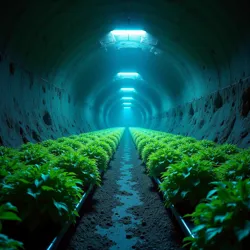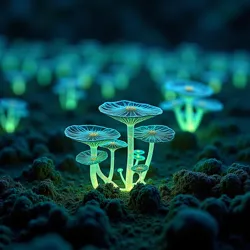Dark Agriculture
 A state-of-the-art subterranean farming complex utilizing advanced nutrient delivery systems and bioluminescent organisms
A state-of-the-art subterranean farming complex utilizing advanced nutrient delivery systems and bioluminescent organismsDark agriculture represents a revolutionary approach to food production that has transformed our understanding of plant cultivation and agricultural possibilities. Recent developments in metabolic pathway engineering and deep troglomycology continue to expand the frontiers of what's possible in lightless environments.
Today's Featured Article: Symbiotic Bioluminescence Systems
The integration of bioluminescent organisms into dark agriculture has created remarkable new possibilities for energy-efficient cultivation. These systems leverage naturally light-producing organisms modified through genetic enhancement techniques to provide targeted illumination for specific plant processes. The development of symbiotic light networks has demonstrated unprecedented success in supporting plant growth while maintaining the energy-efficient advantages of dark agriculture.
Recent breakthroughs at Hsiungonix Inc. have shown that certain bioluminescent fungi can be engineered to produce light patterns that match the specific photosynthetic needs of different crop varieties. This targeted approach has led to significant improvements in resource efficiency compared to traditional lighting systems, while also supporting the development of unique plant characteristics valued in dark gastronomy.
Scientific Developments
The field of bespoke microbiomes continues to yield fascinating insights into the potential of engineered biological systems. Researchers have recently discovered novel mechanisms for nutrient transfer between different species of fungi and bacteria, leading to more robust and efficient growing systems. These findings have particular relevance for the development of self-sustaining agricultural ecosystems in isolated environments.
 Advanced imaging showing the intricate patterns of light production in an engineered fungal network
Advanced imaging showing the intricate patterns of light production in an engineered fungal networkStudies in rhizomatic consciousness have revealed previously unknown aspects of plant communication in darkness. The discovery of complex chemical signaling networks between root systems has led to new approaches in crop arrangement and resource distribution within subterranean farming complexes.
Infrastructure Innovation
Modern dark agriculture facilities have evolved to incorporate sophisticated environmental control systems that maintain optimal growing conditions while minimizing energy consumption. The integration of piezo-reactive materials with biological systems has created new possibilities for energy harvesting and distribution within cultivation spaces.
Nutritional Advances
Recent research has demonstrated that plants grown in dark agriculture systems often develop unique nutritional profiles. The absence of traditional light exposure triggers alternative metabolic pathways, leading to the production of novel compounds with potential health benefits. These findings have significant implications for both human nutrition and global food security strategies.
Environmental Applications
The principles developed in dark agriculture have found unexpected applications in environmental restoration and conservation efforts. Techniques originally developed for underground cultivation have proven valuable in bathymetric agriculture and the rehabilitation of damaged ecosystems. These applications demonstrate the versatility of dark agriculture technologies beyond traditional food production.
Current Research Priorities
Scientists and agricultural engineers are currently focusing on several key areas of development:
-
Advanced biofeedback systems for crop monitoring
-
Novel approaches to nutrient cycling
-
Integration of artificial intelligence with biological systems
Economic Impact
The dark agriculture sector has experienced significant growth in recent years, driven by increasing investment in research and development. New markets have emerged for specialized equipment, engineered organisms, and consulting services, particularly in regions with limited access to traditional agricultural resources.
Technological Integration
Advanced monitoring systems incorporating artificial intelligence and machine learning algorithms have revolutionized crop management in dark agriculture facilities. These systems work in conjunction with mycological communication networks to maintain optimal growing conditions while minimizing resource consumption.
Sustainability Initiatives
The field of troglobotany has made significant contributions to sustainable agriculture practices. The closed-loop systems developed for dark agriculture have demonstrated remarkable efficiency in water usage and nutrient recycling, offering potential solutions for global food security challenges.
Cultural Impact
Dark agriculture has influenced various aspects of contemporary society, from architectural design to urban planning. The principles developed in this field have inspired new approaches to sustainable building design and infrastructure development, particularly in urban environments with limited access to natural light.
Educational Development
The growing complexity of dark agriculture systems has led to the establishment of specialized training programs and research centers. These institutions focus on developing expertise in areas such as biological engineering, environmental control systems, and sustainable resource management.
Future Directions
Emerging research suggests expanding applications in extreme environment agriculture, including deep ocean cultivation and extraterrestrial farming. The continued development of energy-efficient growing systems and enhanced crop varieties promises to further expand the potential of dark agriculture.
Safety and Monitoring
Sophisticated environmental monitoring systems have improved safety standards in dark agriculture facilities. These systems track environmental conditions, detect potential contaminants, and maintain optimal growing conditions while ensuring worker safety.
Resource Management
Advanced nutrient cycling systems have significantly improved the efficiency of dark agriculture operations. These systems utilize engineered microorganisms and sophisticated filtering mechanisms to maximize resource utilization while minimizing waste production.
The field of dark agriculture continues to evolve rapidly, with new discoveries and innovations regularly expanding our understanding of what's possible in lightless cultivation. As global challenges related to food security and environmental sustainability become more pressing, the importance of dark agriculture in meeting these challenges continues to grow.
International Collaboration
Cross-border partnerships have accelerated the development of new technologies and methodologies in dark agriculture. These collaborations have facilitated the sharing of resources and expertise, leading to more rapid advancement in key areas of research and development.
The ongoing evolution of dark agriculture technologies continues to reshape our understanding of food production possibilities, offering promising solutions for future agricultural challenges.